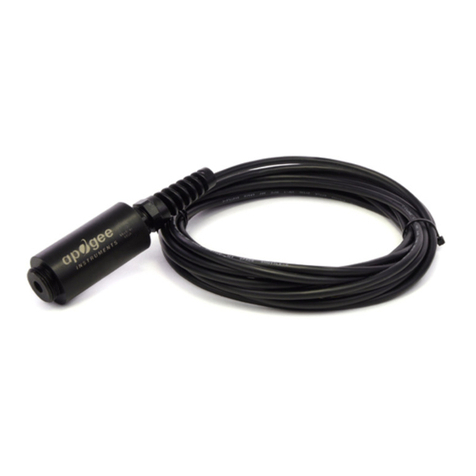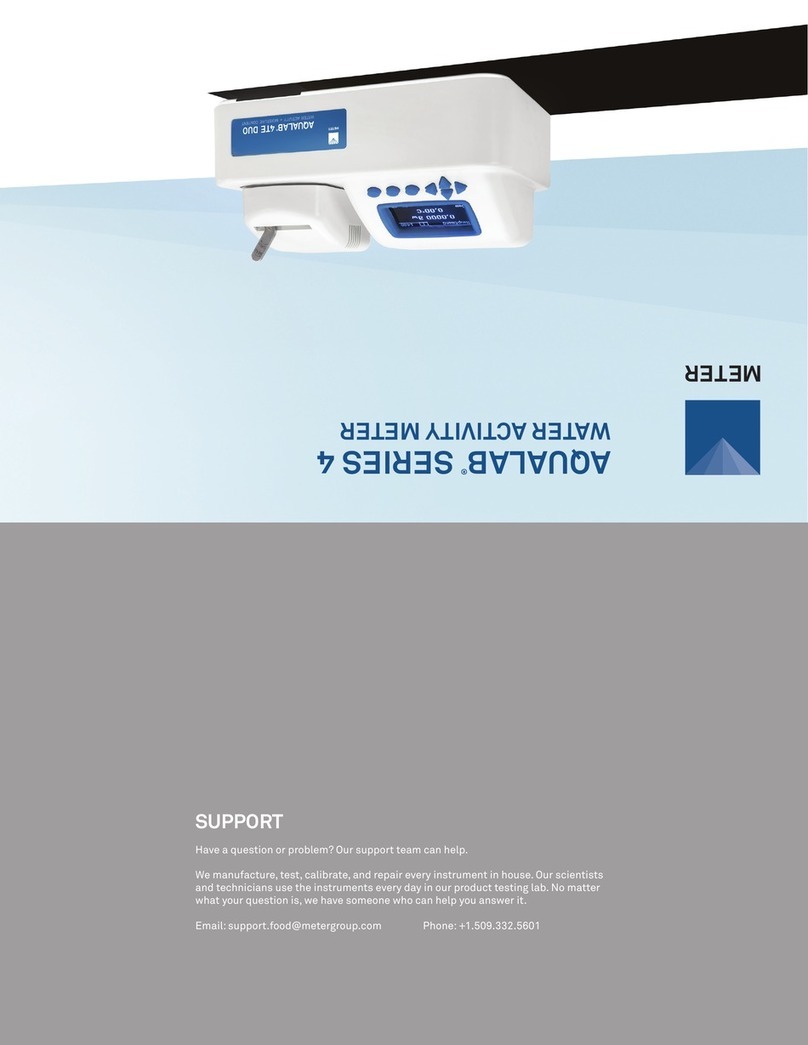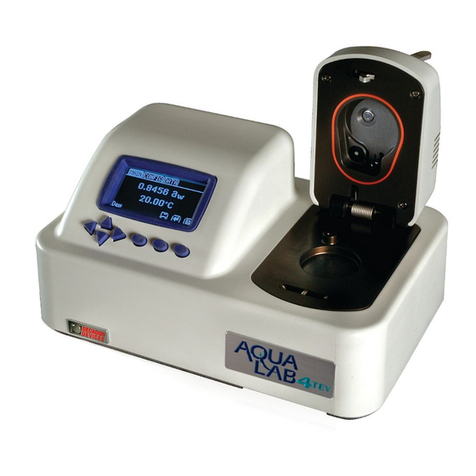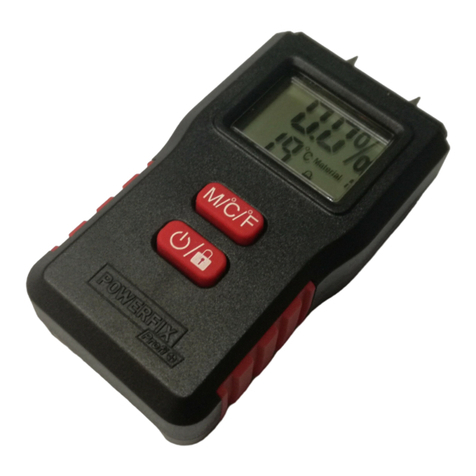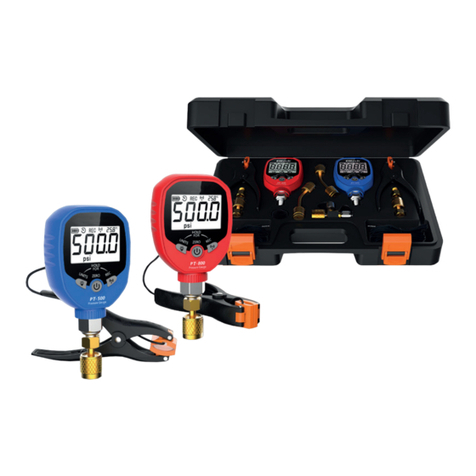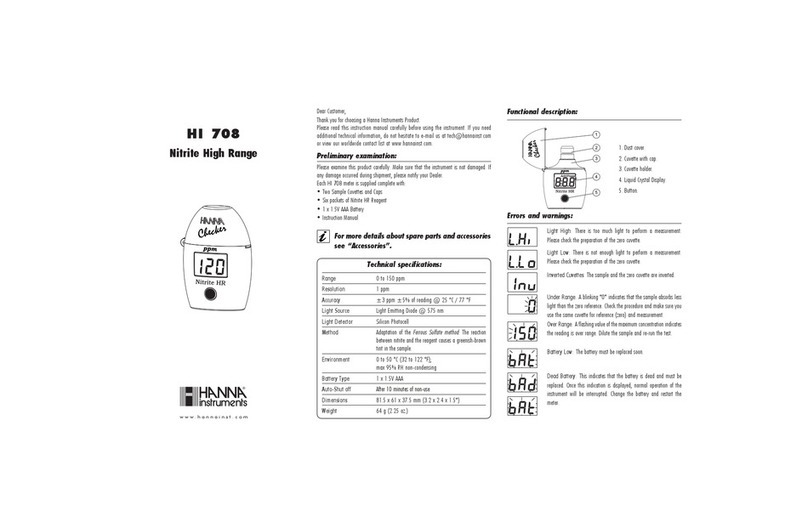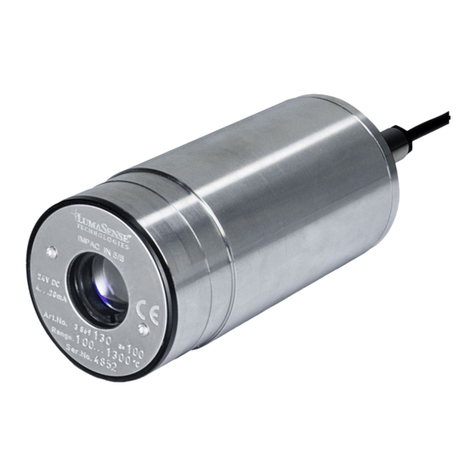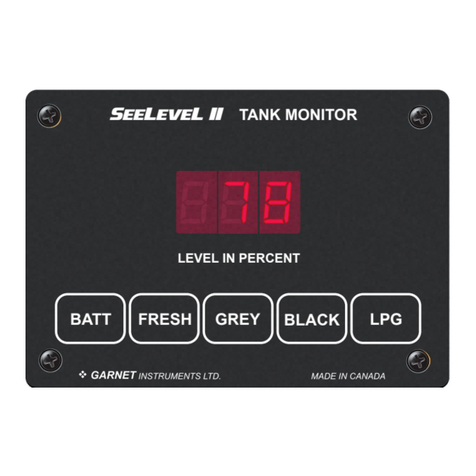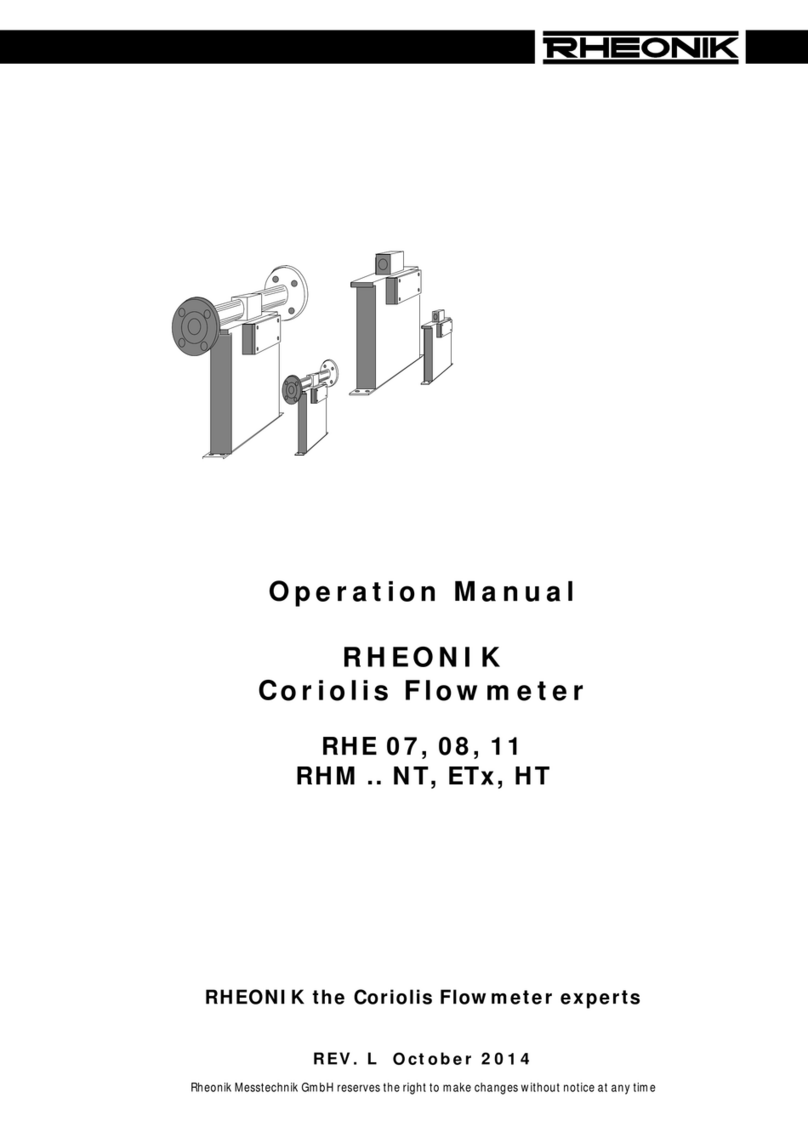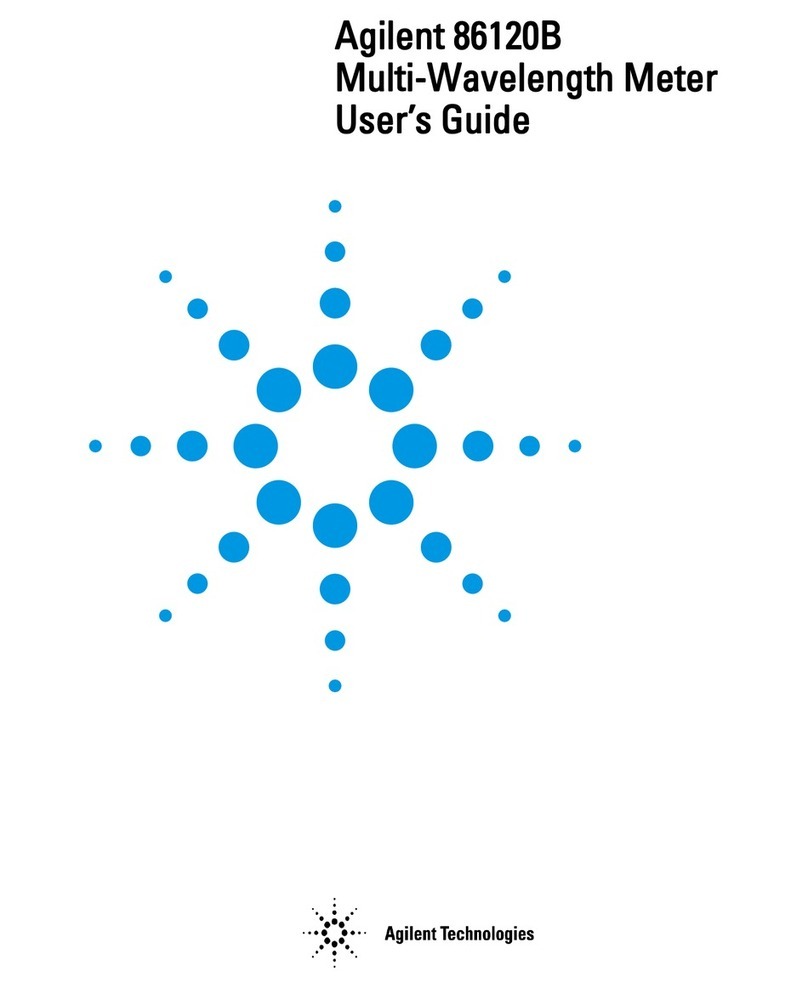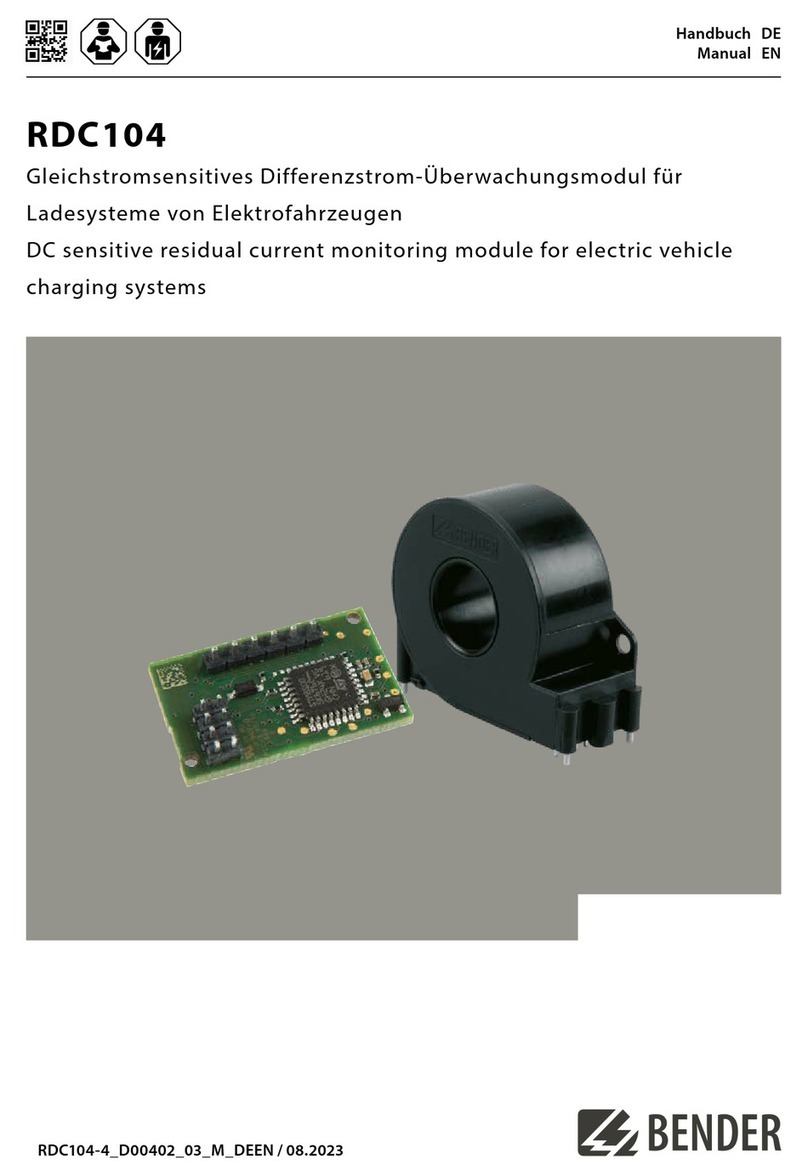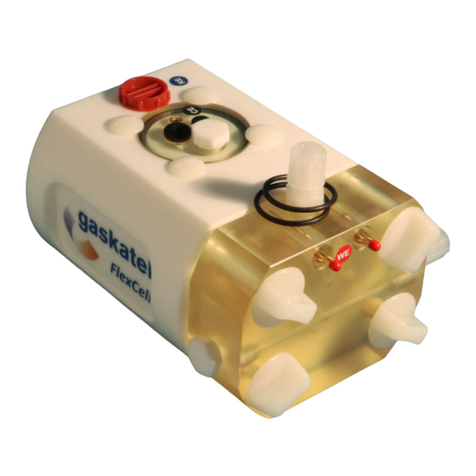METER GROUP WP4C User manual

WP4C
Dew Point PotentiaMeter
Operator’s Manual
Distributed & Supported By:
www.edaphic.com.au
Ph: 1300 430 928

WP4C
METER Group, Inc.
2365 NE Hopkins Court
Pullman WA 99163
Phone: 509-332-5600
Fax: 509-332-5158
Website: www.metergroup.com
sales.environmen[email protected]
Trademarks
c
2017 METER Group, Inc.
All Rights Reserved
ii

WP4C CONTENTS
Contents
1 Introduction 1
1.1 Customer Support . . . . . . . . . . . . . . . . . . . . 1
1.2 About This Manual . . . . . . . . . . . . . . . . . . . 2
1.3 Warranty ......................... 2
1.4 Seller’s Liability . . . . . . . . . . . . . . . . . . . . . . 2
2 About the WP4C 4
2.1 Specifications ....................... 4
2.2 WP4C and Water Potential . . . . . . . . . . . . . . . 5
2.3 How the WP4C works . . . . . . . . . . . . . . . . . . 5
2.4 WP4C and Temperature . . . . . . . . . . . . . . . . . 6
3 Getting Started 7
3.1 Components of your WP4C . . . . . . . . . . . . . . . 7
3.2 Choosing a Location . . . . . . . . . . . . . . . . . . . 7
3.3 Features.......................... 8
3.4 Preparing the WP4C for Operation . . . . . . . . . . . 8
3.5 Portability......................... 9
4 The Menus 11
4.1 TheMainMenu...................... 11
4.1.1 Changing Languages . . . . . . . . . . . . . . . 11
4.1.2 Reading Modes . . . . . . . . . . . . . . . . . . 12
4.2 System Configuration . . . . . . . . . . . . . . . . . . 14
4.3 Sample Equilibration Screen . . . . . . . . . . . . . . . 17
5 Calibration and Verification 19
5.1 Verification ........................ 19
5.2 Verification Standards . . . . . . . . . . . . . . . . . . 19
5.3 When to Verify Calibration . . . . . . . . . . . . . . . 19
5.4 How to Verify and Calibrate the WP4C . . . . . . . . 20
6 Sample Preparation 22
6.1 Choosing a Sample Cup . . . . . . . . . . . . . . . . . 22
6.2 Preparing the Sample . . . . . . . . . . . . . . . . . . 22
6.3 DrySamples ....................... 23
6.4 Samples and Temperature . . . . . . . . . . . . . . . . 24
6.5 Measuring Plant Samples . . . . . . . . . . . . . . . . 25
iii

CONTENTS WP4C
6.6 Taking a Reading . . . . . . . . . . . . . . . . . . . . . 25
6.7 How WP4C takes Readings . . . . . . . . . . . . . . . 25
7 Computer Interface 27
7.1 AquaLink 4 Software . . . . . . . . . . . . . . . . . . . 27
7.2 Using a Communication Program . . . . . . . . . . . . 28
8 Theory: Water Potential 30
8.1 Water Potential . . . . . . . . . . . . . . . . . . . . . . 30
8.2 Measuring Water Potential . . . . . . . . . . . . . . . 30
8.3 Effect of Temperature on Water Potential . . . . . . . 31
8.4 Estimating Osmotic Potential . . . . . . . . . . . . . . 32
9 Cleaning and Maintenance 33
9.1 Accessing the Block . . . . . . . . . . . . . . . . . . . 33
9.2 Cleaning Procedure . . . . . . . . . . . . . . . . . . . . 34
9.3 Checking Calibration . . . . . . . . . . . . . . . . . . . 37
10 Repair Instructions 38
10.1 Shipping Directions . . . . . . . . . . . . . . . . . . . . 38
10.2RepairCosts ....................... 39
10.3 Loaner Service . . . . . . . . . . . . . . . . . . . . . . 39
11 Troubleshooting 40
11.1 Problems and Solutions . . . . . . . . . . . . . . . . . 40
11.2 Sensor Performance Screen . . . . . . . . . . . . . . . 44
12 Further Reading 46
12.1 Application Notes . . . . . . . . . . . . . . . . . . . . 46
13 Appendix A 48
13.1 Preparing Salt Solutions . . . . . . . . . . . . . . . . . 48
14 Appendix B 49
15 Declaration of Conformity 50
16 Certificate of Traceability 51
iv

WP4C 1 INTRODUCTION
1 Introduction
Welcome to METER’s WP4C Dew Point PotentiaMeter, the research
standard for measuring water potential. WP4C is the fastest, most
accurate, and most reliable instrument available for measuring water
potential using the chilled-mirror dew point technique. The WP4C
suits the needs of the scientist and student. It is easy to use and
provides fast, accurate results. We hope you find this manual infor-
mative and helpful in understanding how to maximize the capabilities
of your WP4C.
1.1 Customer Support
There are several ways to contact METER if you ever need assis-
tance with your product, have any questions, or feedback. METER
has Customer Service Representatives available to speak with you
Monday through Friday, between 7 am and 5 pm Pacific time.
Note: If you purchased your WP4C through a distributor, please
contact them for assistance.
Email:
Phone:
509-332-5600
Fax:
509-332-5158
If contacting us by email or fax, please include as part of your mes-
sage your instrument serial number, your name, address, phone, fax
number, and a description of your problem or question.
1

1 INTRODUCTION WP4C
1.2 About This Manual
Please read these instructions before operating your Potentia Meter
to ensure that it performs at full potential. This manual includes
instructions for setting up, calibrating, and maintaining the WP4C.
Please read these instructions before operating WP4C to ensure that
the instrument performs to its full potential. This manual will aid
end users in understanding the basic concepts of water potential and
enable them to use our instrument with confidence. Every effort has
been made to ensure that the content of this manual is correct and
scientifically sound.
1.3 Warranty
This device has a 30-day satisfaction guarantee and a one-year war-
ranty on parts and labor. Your warranty is automatically validated
upon receipt of the instrument.
1.4 Seller’s Liability
Seller warrants new equipment of its own manufacture against de-
fective workmanship and materials for a period of one year from the
date of receipt of equipment.
Note: We do not consider the results of ordinary wear and tear,
neglect, misuse, or accident as defects.
The Seller’s liability for defective parts shall in no event exceed the
furnishing of replacement parts “freight on board” the factory where
originally manufactured. Material and equipment covered hereby
which is not manufactured by Seller shall be covered only by the
warranty of its manufacturer. Seller shall not be liable to Buyer for
loss, damage or injuries to persons (including death), or to property
or things of whatsoever kind (including, but not without limitation,
loss of anticipated profits), occasioned by or arising out of the instal-
lation, operation, use, misuse, nonuse, repair, or replacement of said
material and equipment, or out of the use of any method or process
2

WP4C 1 INTRODUCTION
for which the same may be employed. The use of this equipment con-
stitutes Buyer’s acceptance of the terms set forth in this warranty.
There are no understandings, representations, or warranties of any
kind, express, implied, statutory or otherwise (including, but with-
out limitation, the implied warranties of merchantability and fitness
for a particular purpose), not expressly set forth herein.
3

2 ABOUT THE WP4C WP4C
2 About the WP4C
2.1 Specifications
Range: 0 to −300 MPa1
Accuracy: ±0.05 MPa1from 0 to −5 MPa
1% from −5 to −300 MPa
Measurement Time:
∼10 to 15 minutes for most soil samples in precise mode
∼20 min. for plant tissue samples
<5 minutes in fast mode (reduced accuracy)
Temperature Control: 15 to 40 ◦C (±0.2 ◦C)
Operating Environment: 5 to 40 ◦C (41 to 104 ◦F)
Sensor Type: A chilled-mirror dew point sensor and an Infrared
temperature sensor
Sample Cup Capacity: 7 mL recommended (15 mL full)
Dimensions: 24.1 x 22.9 x 8.9 cm (9.5 x 9.0 x 3.5 in)
Weight: 3.2 Kg (7.1 lbs)
Case Material: Powder Painted Aluminum
Display: 20 x 2 alphanumeric LCD with backlighting
Data Communication: RS232A compatible, 8-data bit ASCII code,
9600 baud, no parity, 1 stop bit
Power: 110 VAC to 220 VAC, 50/60 Hz
Interface Cable: Standard RS232 to USB cable (included)
Compatible Standards: ASTM D6836-07
Warranty: One year parts and labor
1The WP4C (and all vapor pressure instruments) are limited by accuracy in
the wet end of the water potential range. The range of 0 to −5 MPa has an
accuracy of 0.05 MPa. For example, a measurement at −0.1MPa has an accuracy
of ±50% of the reading and −1 MPa has an accuracy of ±5% of the reading. The
WP4C will not measure water potential accurately near field capacity.
4

WP4C 2 ABOUT THE WP4C
2.2 WP4C and Water Potential
Water potential is a measurement of the energy status of the water
in a system. It indicates how tightly water is bound, structurally or
chemically, within a substance. Water potential can be computed
from the vapor pressure of air in equilibrium with a sample in a
sealed measurement chamber. For a more detailed description of
water potential, please refer to Chapter 9, titled “Theory: Water
Potential” of this manual.
2.3 How the WP4C works
The WP4C uses the chilled mirror dew point technique to measure
the water potential of a sample. In this type of instrument, the
sample is equilibrated with the headspace of a sealed chamber that
contains a mirror and a means of detecting condensation on the mir-
ror. At equilibrium, the water potential of the air in the chamber is
the same as the water potential of the sample. In the WP4C, the mir-
ror temperature is precisely controlled by a thermoelectric (Peltier)
cooler. A photoelectric cell detects the exact point at which conden-
sation first appears on the mirror. The WP4C directs a beam of light
onto the mirror, which reflects into a photodetector. The photode-
tector senses the change in reflectance when condensation occurs on
the mirror. A thermocouple attached to the mirror then records the
temperature at which condensation occurs. Values begin to be dis-
played indicating that initial measurements are being taken. WP4C
then signals you by flashing a green LED and/or beeping when it
reaches the final values. The instrument will display the final water
potential and temperature of the sample.
In addition to the technique described above, WP4C uses an inter-
nal fan that circulates the air within the sample chamber to reduce
time to equilibrium. Measuring both dew point and sample surface
temperatures are simultaneously measured, this eliminates the need
for complete thermal equilibrium. The WP4C controls the sample
temperature by means of an internal thermo-electrical module that
monitors and stabilizes the sample block temperature according to
how it is set.
5

2 ABOUT THE WP4C WP4C
2.4 WP4C and Temperature
Large temperature differences, between sample and block, will cause
longer reading times, since a complete and accurate reading will not
be made until the difference between the sample temperature and
the block temperature is less than 1.0 degree. To help you monitor
the temperature difference between your sample and the block, you
can access a Sample Equilibration screen at the Main menu.
6

WP4C 3 GETTING STARTED
3 Getting Started
3.1 Components of your WP4C
Your WP4C should have shipped with the following items.
•WP4C Main Unit
•Quickstart Guide
•Certificate of Calibration
•Power Cord
•RS-232 to USB Cable
•25 Plastic Sample Cups and Lids
•10 Stainless Steel Sample Cups
•Operator’s Manual
•12 Vials of 0.50 mol/kg KCl
•Cleaning Kit
3.2 Choosing a Location
To ensure that your WP4C operates correctly and consistently, place
it on a level surface. This reduces the chance that sample material
will spill and contaminate the inside of the instrument. To protect
the internal electrical components, and to avoid inaccurate readings,
place your WP4C in a location where the temperature remains fairly
stable. This location should be well away from air conditioner and
heater vents, open windows, outside doors, refrigerator exhausts, or
other items that may cause rapid temperature fluctuation.
7

3 GETTING STARTED WP4C
3.3 Features
Figure 1: Front View of WP4C
Figure 2: Back View of WP4C
3.4 Preparing the WP4C for Operation
After finding a good location for your WP4C, plug the power cord
into the back of the unit. Before turning it on, pull open the sample
drawer (turn the knob to the OPEN/LOAD position). You usually
place an empty disposable sample cup upside-down in the drawer to
8

WP4C 3 GETTING STARTED
protect it during shipment. Remove this sample cup and turn the
instrument on. The ON/OFF switch is located on the lower right
corner of the WP4C back panel. The model and then the main menu
will appear on the LCD.
Then:
This is the Main menu, displaying the water potential in both Mega-
Pascals (MPa) and pF, and the sample temperature in ◦C. In order to
provide the most accurate readings, WP4C should ideally be allowed
a warm-up period of 15 to 30 minutes after turning it on. When you
insert a sample into the chamber drawer and turn the drawer knob
to the READ position, the instrument will begin the read cycle to
measure the water potential of your sample.
3.5 Portability
On occasion you may want to take water potential measurements in
the field where it is not feasible to take samples and return to the
lab. The following is a procedure for powering your WP4C using
your vehicle as a power source at sites where AC power is not readily
available.
1. Purchase a portable power inverter that plugs into the 12 V
output (cigarette lighter) of your vehicle. The inverter should
have a continuous output of at least 140 Watts.
9

3 GETTING STARTED WP4C
2. Place the WP4C on a level surface. Care should be taken to
minimize temperature gradients that may affect the instrument
while in the field. A Styrofoam box, for example, will help
minimize temperature effects.
3. Plug the 12-volt inverter to the 12-volt output of the vehicle,
or directly to the battery itself.
4. Plug the WP4C to the inverter, and turn it on. When the
instrument is on, it draws up to 1 amp. Check the rating of
your battery if you want to know how long it will power the
instrument (for example, if your battery is rated for 60 amp
hours, it will work for 60 hours when the vehicle is not running.
5. Allow the instrument to warm up for 15 to 30 minutes as you
would in the lab. Check the calibration of the instrument before
proceeding with reading.
10

WP4C 4 THE MENUS
4 The Menus
4.1 The Main Menu
Every time you turn on your WP4C, it will open to this screen. If
this screen does not appear, refer to Chapter 12 for troubleshooting
instructions. The water potential and sample temperature displays
on the screen. On each side of the LCD there are buttons. Each
button performs a different function depending on which mode you
want. Figure 3 provides a description of the modes and options you
may use and the buttons that set them.
Figure 3: Main Menu Screen
4.1.1 Changing Languages
The WP4C comes to you with English as the default on-screen user
language. If you prefer not to use English, you can change it to one
of a variety of other languages: German, French, Spanish, Italian,
Swedish, Danish, Norwegian, Czech, Portuguese, Japanese, Polish or
11

4 THE MENUS WP4C
Finnish. Change languages by pressing the upper right button of
the instrument while it is not reading a sample. You will see the
Language screen with default English.
Press the upper right key again, and the next language option (Ger-
man) will appear.
Each time you press the right button, the display will scroll to the
next language option. Select the language you prefer and press the
lower left button to exit.
4.1.2 Reading Modes
Precise Mode
When you first turn on the WP4C, it will be in precise mode. The
WP4C repeats sample measurements until successive readings agree
within a preset tolerance (0.03 MPa for Ψ >−40 MPa; otherwise
0.3 MPa). The WP4C always starts in precise mode. To toggle
between the precise, continuous and fast modes, press the top left
button. The display will show a small p, c or f to the left of the
water potential readings.(Figure 4)
12

WP4C 4 THE MENUS
Figure 4: Main Menu with Continuous Mode Enabled
Precise mode ensures a precise water potential value by repeating
measurements on a sample. Typical read times are within 10 to 15
minutes. The green LED blinks until you turn the drawer know to
the OPEN/LOAD position.
Continuous Mode
Continuous mode measures the water potential of your sample con-
tinuously until you turn the drawer knob to the OPEN/LOAD po-
sition. This can be useful in doing long term monitoring of samples
that take an especially long time to come to vapor equilibrium, such
as plant samples and moist soil samples with water potential >−0.5
MPa. In this mode the WP4C will measure the sample, stop to dis-
play the water potential and sample temperature, then begin another
read cycle. Between samples, it will signal you with the green LED
flash, accompanied by the beeper, if enabled. Some find it helpful
to connect their WP4C to a computer while in continuous mode in
order to log and store data over time. For instructions on how to do
this, see Chapter 8.
Fast Mode
In fast mode, the sample is measured only once. Read time is typ-
ically 3 to 5 minutes. Readings are less precise, particularly in the
wet range. However, fast mode is recommended for dry soil samples
with water potential <−40 MPa.
13

4 THE MENUS WP4C
4.2 System Configuration
If you press the bottom left button while in the Main menu, it will
bring you to the System Configuration menu. This menu allows you
to make minor system changes.(Figure 5 and 6)
Figure 5: Main Menu Buttons
You can change how the beeper signals after each reading and enter
the calibration menu as well.
Figure 6: System Configuration Menu
Changing the Beeper
When you are reading, the WP4C has two ways of notifying you
when it completes the water potential reading for your sample. It
will notify you with the beeper he beeper and a flashing green LED,
14

WP4C 4 THE MENUS
located on the left front corner of the WP4C case. In fast and pre-
cise reading modes, the LED will flash once when a sample is started.
When it is finished the LED will flash continuously until the knob is
moved to the OPEN/LOAD position (if not operating in continuous
mode). You cannot turn off or change the LED flashing functions.
Three different icons represent the three beeper options.(Figure 7)
Figure 7: Definition of Beeper Icons
you can turn the beeper off completely, set it to beep momentarily
(four times) when the sample is finished and then stop, or to beep
continuously until you turn the knob to the OPEN/LOAD position.
After you have adjusted the beeper setting, it will remain as you have
set it until you change it again, and will not be affected by turning
the instrument on or off.
EXIT
You may press the Exit button (the lower left button) to exit back
to the main menu at any time.
Adjusting Calibration
When you need to adjust calibration, press the upper right button
in the System Configuration menu, and you will be brought to the
Calibration menu. For more details on calibration and how to verify
it, please refer to the Calibration and Verification chapter.
Setting the Temperature
15

4 THE MENUS WP4C
The WP4C gives you the ability to manually set your instrument
sample chamber temperature. To set your instrument sample cham-
ber temperature, press the lower right button next to the “set T” in
the System Con
guration menu. The following screen will appear:
Adjusting the Setpoint Temperature
Use the buttons next to + and −to adjust the target setpoint tem-
perature (displayed in the lower right corner). If you press either
button it adjusts in increments of 0.1 ◦C.
Note: Holding down the button will rapidly increment the value.
The target setpoint temperature roughly corresponds to the tem-
perature at which you wish the sample to read. Adjust the setpoint
to the temperature that you want, then begin measurements to see
how close your WP4C comes to your desired temperature (this works
best by putting the WP4C in continuous mode). After several sam-
ples, it should show consistent temperature readings. At this point,
make any needed adjustment to the setpoint index number to reach
your desired temperature. You will be able to adjust the index num-
ber between 15 and 40 ◦C. If you press the −button after you reach
15 ◦C, it will disable the temperature control function until you raise
the index number again. When the temperature control is disabled
the display will show ‘off’ in place of the temperature setting.
Important tips with the WP4C
•Before reading, wait for approximately 30 minutes to let the
chamber temperature stabilize after turning it on.
16
Table of contents
Other METER GROUP Measuring Instrument manuals
Popular Measuring Instrument manuals by other brands
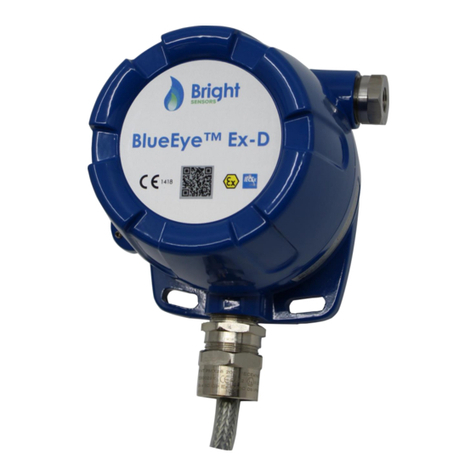
BRIGHT
BRIGHT BlueEye Ex-D operating manual
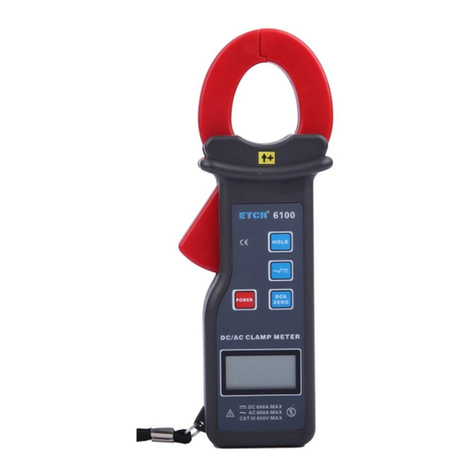
ETCR
ETCR 6100 user manual
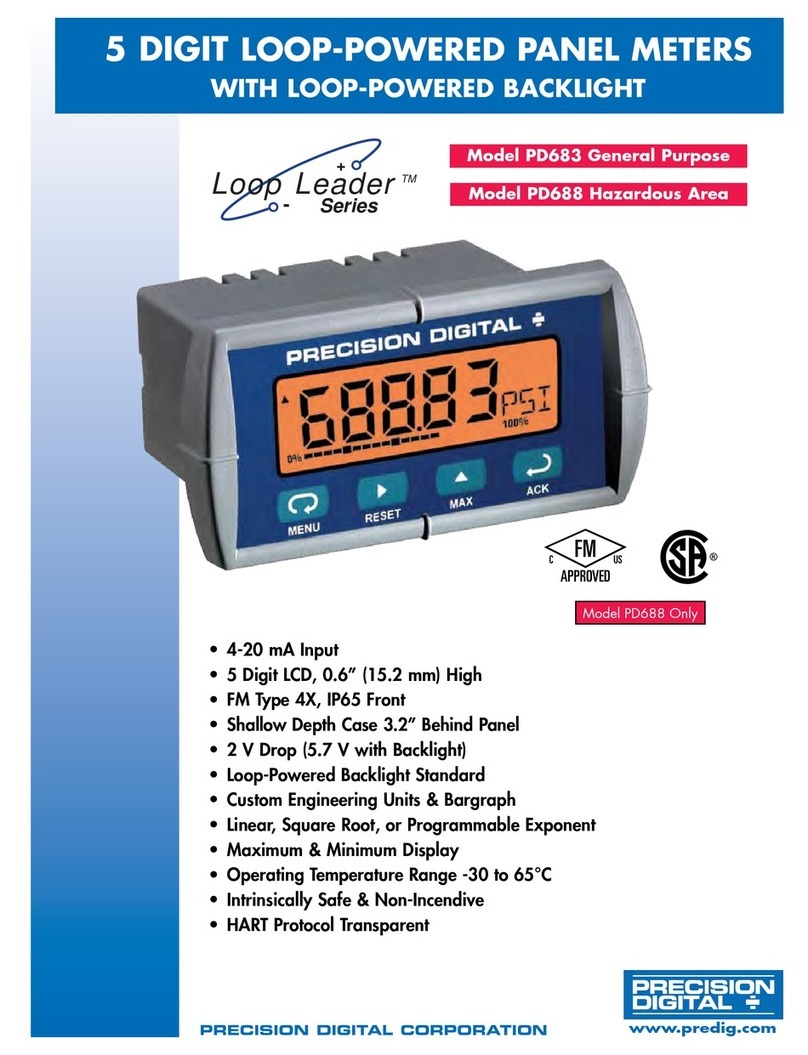
PRECISION DIGITAL
PRECISION DIGITAL Loop Leader PD683 manual
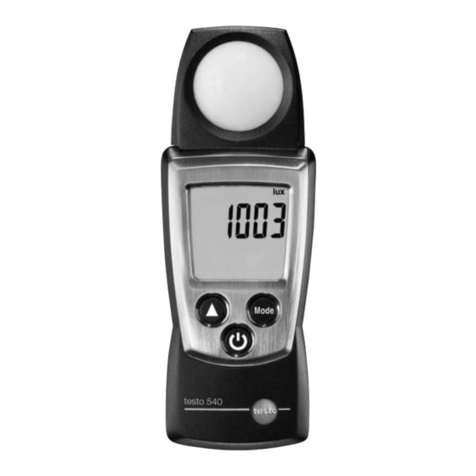
TESTO
TESTO 540 instruction manual
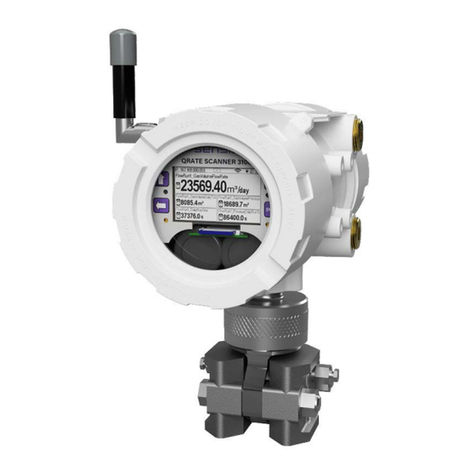
Rockwell Automation
Rockwell Automation Sensia Qrate Scanner 3100 Installation, operation & maintenance manual

Renkforce
Renkforce 1342395 operating instructions
